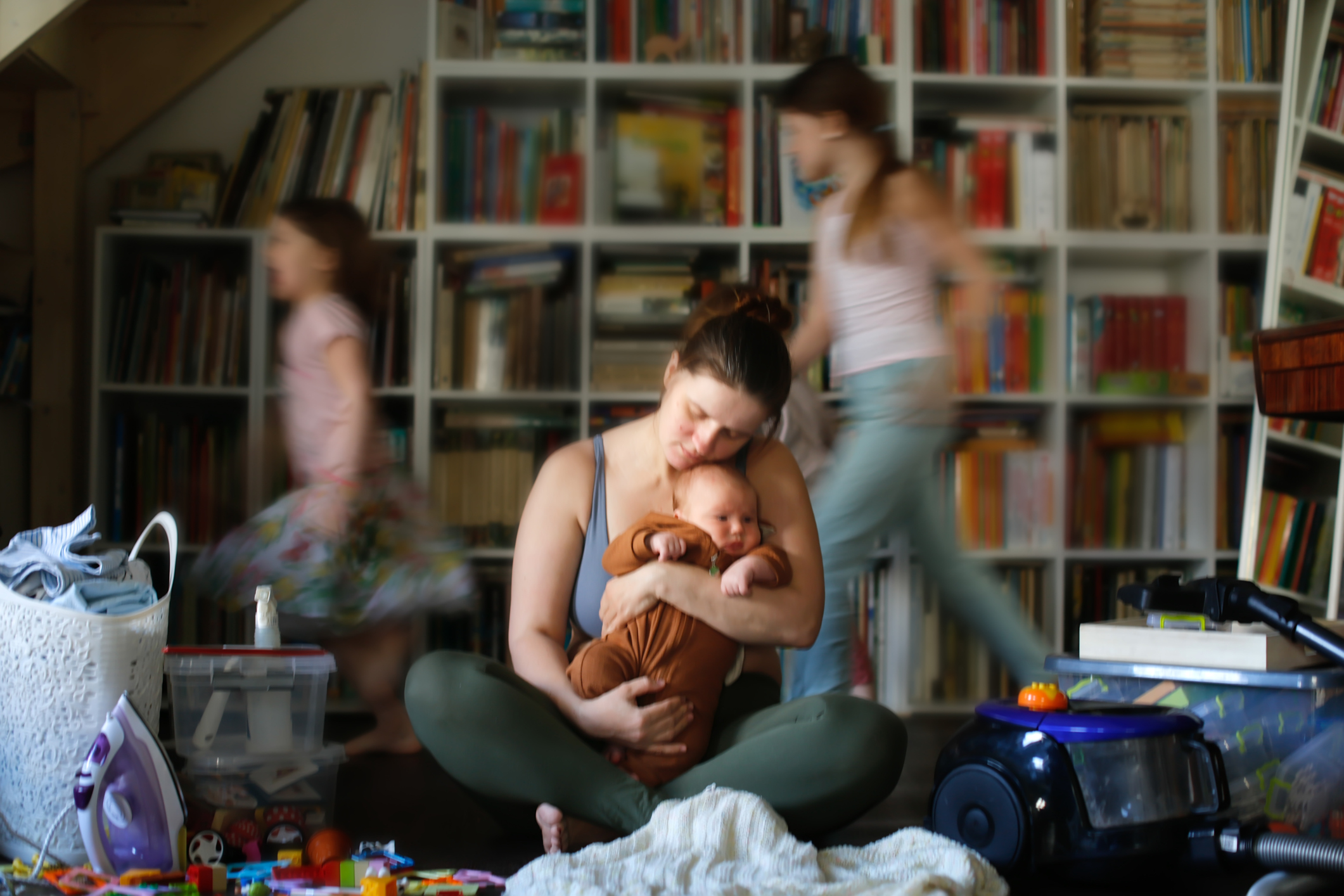A subversive message for Mother's Day
Trickle-Down Dysfunction

Why an end to monogamy is bad news for us all.
G.K. Chesterton famously said never to take a fence down until you know the reason it was put up in the first place. But one very important fence is being dismantled, with little attention to the potential negative consequences: the fence of monogamy. Astonishingly, a third of American adults now say that their ideal relationship is non-monogamous.
The monogamous nuclear family has been one of the central targets for abolition by progressives since at least the dawn of Marxism, and the new push for fads like so-called “ethical non-monogamy” and polyamory is just the latest front in a long-running war. In The Origin of the Family, Private Property and the State (1884), Friedrich Engels used some sketchy early anthropology to argue that man’s natural state, before the emergence of class society, was a primitive matriarchy in which women were of at least an equal status to men and mating was “promiscuous.” In many respects, in a society where men cannot compel women to have sex with them, women hold the upper hand since they control society’s means of reproduction. The historical emergence of class society begins, according to Engels, with the idea that men can own women. From this basic idea, in time, emerged the various fundamental institutions of capitalist class society: private property, the nuclear family, and the state.
The clear implication of Engels’s evolutionary scheme—from primitive matriarchy to class society and then, via the proletarian revolution, to communism—was that the overthrow of modern capitalist society would take man back to a new kind of primitive matriarchy, where reproduction would once again be promiscuous, as it had been before men had the idea that women were commodities. It’s not a wonder that Origin became a central text for radical feminists of the sixties and seventies, who extended its central arguments about women’s subjugation to men to justify their rebellion against social norms and spread the message that nothing good can come of a stable two-parent household with one or more children in it.
What the return to societal non-monogamy would look like in real terms was left largely unspoken by Engels in Origin, but increasingly we’re getting an idea—and it doesn’t look good. As society becomes more sexually promiscuous, and polyamorous relationships become more prominent, the trickle-down effects will prove to be severe. The sharing of bodies and the erosion of time-honored traditions won’t go unpunished. The centrality of monogamy to our civilization is clear, even if you don’t believe Engels’s evolutionary account of why. We’re not going to be arguing for enforced monogamy Jordan Peterson-style, just pointing to some cold, hard facts. If you destroy one of the central institutions of a civilization, you’d better have something compelling—and functional—to offer instead. Unless, of course, your goal is chaos.
According to the anthropological record, perhaps as many as 85% of human societies have practiced some form of polygamy, with polygyny (a husband with multiple wives) being the most common form. Monogamy presents something of a puzzle for students of human history, because large absolute differences in wealth within societies should favor polygyny rather than monogamy. This is why, in virtually every empire throughout history, rulers were able to amass huge harems: you’ve probably already heard the claims about how many million Eurasian men are descended from Genghis Khan, for instance. And yet, for at least about 1,500 years in European society, and now across the rest of the planet, monogamous marriage has been the norm, despite growing absolute wealth differences.
Why? Because monogamy is a beneficial social institution on a number of levels. By “suppressing intrasexual competition,” as one review study puts it, monogamy reduces violent crime between men and between the sexes, including sexual crime. Reduced competition for young brides reduces the age gap between spouses, suppresses fertility beneficially, and reduces gender inequality. It also means that men can concentrate their economic efforts on something other than supporting as many wives as possible: more money can be invested in the individual members of a monogamous household, as well as in other enterprises. Importantly, the tight biological bonds of the nuclear family are also a shield for its members. All the evidence shows that spouses and children within monogamous households are subject to less neglect, abuse, accidental death, and homicide than spouses and children in polygynous households. All in all, this sounds pretty good.
With regard to the last set of benefits—the “biological shield,” if you will—we are already seeing the damage the new style of polyamorous relationships can do, especially if a child is involved. Let’s take one high-profile case. In 2020, there was a media circus around an American woman called Tory Ojeda. Twenty-year-old Ojeda, who was pregnant at the time, was in an open relationship with four live-in boyfriends, one of whom—apparently—was the father of her child.
“My family is slowly coming around to the idea,” Tory said in an interview with the Daily Mail. “The pregnancy has helped with that. But at the very beginning, I know my mother and father were hesitant about it.” She expressed hope that relationships like hers, despite the continuing “judgement in public spaces,” would become more common. “We’re all raising the baby together—so everyone’s Dad,” she said.
Except, of course, everyone isn’t Dad. There can only be one Dad—one biological father. And so it was with depressing inevitability that not long after the initial fanfare, there came horrible news. Tory’s daughter was admitted to the hospital at five weeks old with broken ribs, injuries to her lungs and liver, and multiple bleeds on the brain. The severity of the attacks suggested the baby had been attacked at least three times by Ethan Baucom, who is not the baby’s father, while she was left with him for the day. He had apparently become frustrated when the baby wouldn’t go to sleep. While the baby was expected to make a full recovery, and Baucom was sent to jail where he belongs, the fact remains that the baby was sent home into the care of two other men who were also not her father. What’s to stop such abuse from happening again?
If “unconventional” polyamorous families are potentially putting children at risk, this is only the beginning of the problems that abandoning traditional structures of responsibility and care-giving is causing. We’ve all heard of trickle-down economics, but there’s also such a thing as trickle-down dysfunction too. Slightly further downhill from polyamorous families are new forms of adoption, mainly involving same-sex couples. The number of children in the U.S. care system has grown dramatically since the mid-20th century, clearly as a result of the changes of the sexual revolution, meaning there are always huge numbers of children waiting to be adopted.
In 2013, author and critic Robert Oscar Lopez noted, “were changing views of same-sex parenting based on a natural, organic process of cultural adaptation, that would be fine, but instead views are being coercively changed through a same-sex marriage movement.” Two years after these wise words, the U.S. Supreme Court struck down all state bans on same-sex marriage and legalized it nationally. Same-sex adoption has grown massively since then.
Same-sex couples are four times more likely than opposite-sex couples to adopt a child. That sounds like good news for the children, who get to live in a loving home. Other statistics should give us reason to pause. Studies have shown that same-sex relationships suffer considerably higher levels of domestic violence than heterosexual relationships. Children exposed to domestic violence also tend to be victims of physical abuse. These children are at serious risk of developing long-term mental health problems and engaging in violent behavior. Moreover—and this is a point backed by data—same-sex couples are, according to the psychologist Paul Cameron, “proportionately more apt to abuse foster or adoptive children sexually” than opposite-sex couples.
Children raised by same-sex parents are at a considerably greater risk of developing anxiety, depression, and suicidality. They are also more likely to be bullied and have various behavioral problems. Children raised by same-sex parents are more likely to report same-sex attraction than children raised by opposite-sex parents. Sexual orientation is an inseparable interplay of genetics and environmental influences. As more and more children are raised by same-sex couples, we should expect to see the already incredibly high number of children identifying as gay to keep on increasing. Transgender adoption, too, appears to be on the rise.
Other same-sex couples turn to surrogacy, to which all the above points apply, as well as others. Fears about the parenting capabilities of same-sex couples won’t be assuaged by paying attention to social media, where videos circulate of new surrogate parents describing the process of choosing an egg donor. “I wanted her to have really thick hair, because I’ve had two hair transplants. I wanted her to have a really wide, nice smile. And just look like a kind person,” one surrogate father gushed, unaware, perhaps, that he sounded like he was picking out a new handbag or a pet—anything other than the living breathing mother of a child who would be taken from her forever not long after it was born. The ethics of surrogacy deserve an article all to itself.
There is no institution that can replace traditional monogamy and fulfill the same functions. The Marxist and feminist dream of replacing monogamy is just that—a dream that is, on closer inspection, indistinguishable from a nightmare.
The American Mind presents a range of perspectives. Views are writers’ own and do not necessarily represent those of The Claremont Institute.
The American Mind is a publication of the Claremont Institute, a non-profit 501(c)(3) organization, dedicated to restoring the principles of the American Founding to their rightful, preeminent authority in our national life. Interested in supporting our work? Gifts to the Claremont Institute are tax-deductible.
Homemaking is a daily battle for self-governance in an increasingly hostile world.
Having designer babies the old-fashioned way.
Hospitals are so committed to gender ideology that they are willing to break the law.
The regime is desperate to impose polyamory.
Who’s accountable when violence happens?






